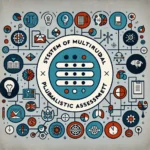System of Multicultural Pluralistic Assessment (SOMPA) – Unveiling Fairness in Student Evaluation
In the realm of educational psychology, a key challenge has always been the fair and comprehensive assessment of students from diverse cultural backgrounds. Traditional standardized testing has often been criticized for its bias towards the cultural norms of the majority population, which can lead to misdiagnosis and unfair educational placements for minority students. Enter the System of Multicultural Pluralistic Assessment (SOMPA), a trailblazing approach designed to facilitate more equitable assessments of students from varying ethnic and cultural backgrounds.
Understanding SOMPA
SOMPA was developed in the 1970s primarily by Mercer and Lewis as an alternative to traditional standardized tests. It seeks to provide a multifaceted evaluation that takes a student’s cultural and social background into account. Instead of judging all students against a single standard which often reflects the dominant culture, SOMPA incorporates metrics that assess a student’s abilities within the context of their own cultural experiences.
Key Components of SOMPA
The System of Multicultural Pluralistic Assessment consists of several key components that work together to provide a more equitable evaluation system. These include:
1. The Medical Model: The medical model component of SOMPA involves a comprehensive health screening. This helps to rule out any medical issues that could impact a child’s performance in school. By identifying and addressing health-related concerns, educators and parents can better understand and accommodate any health challenges that a student may face.
2. The Social System Model: This part of the assessment looks at the student’s environment, including family, community, and school systems. It examines external factors like socioeconomic status, parental education levels, and external stressors that could affect a student’s learning and performance.
3. The Pluralistic Model: This model acknowledges the different cultural backgrounds of students and assesses their abilities based on their cultural learning styles and experiences. It is designed to minimize bias by acknowledging and valuing the diverse ways of knowing and learning that students bring to the classroom.
Benefits of SOMPA
SOMPA offers several benefits over traditional assessment methods:
1. Cultural Relevance: One of the most significant advantages is its cultural relevance and sensitivity. It acknowledges that children are a product of their unique environments and experiences, and therefore, assessments must consider these factors to be fair.
2. Early Identification: With a comprehensive health screening, SOMPA helps in identifying any potential health issues that could impact learning. This early identification allows for prompt interventions that can significantly improve academic outcomes.
3. Individualized Assessment: Because SOMPA takes a close look at the individual’s social and cultural context, it promotes individualized assessments. This offers a clearer picture of a student’s abilities and potential, leading to more tailored educational plans.
4. Reducing Misdiagnosis: For years, minority students have been disproportionately diagnosed with disabilities and placed in special education programs. SOMPA’s pluralistic approach reduces the likelihood of such misdiagnoses, ensuring that students receive the appropriate educational pathways.
Challenges and Criticisms of SOMPA
Despite its strengths, SOMPA is not without its challenges. Critics argue that the system requires highly trained professionals to administer accurately and can be time-consuming to carry out effectively. There are also concerns regarding the practicality of implementing SOMPA on a large scale, given the resource-intensive nature of its model.
Moreover, some educators argue that while SOMPA attempts to eliminate bias, it cannot ensure complete objectivity. Biases are inherent in any assessment, and critiques suggest that any test that categorizes by ethnic backgrounds can reinforce stereotypes. Additionally, the evolving definitions of culture and identity call for continuous updates to the SOMPA framework.
The Future of SOMPA in Educational Settings
The educational landscape continues to evolve, and so too must the methods educators use to assess their students. As populations become increasingly diverse, systems like SOMPA will be vital in ensuring that students receive fair and equitable evaluations. Ongoing research and development are essential to refine SOMPA and similar assessment tools to better serve the needs of all students.
The potential for technology integration also presents an opportunity for modernizing SOMPA. With advancements in AI and machine learning, there is the capacity to improve the system’s efficiency and reach. EdTech solutions could lead to quicker assessments that still maintain the cultural sensitivity and individualized insight that is the hallmark of SOMPA.
Inclusive Practices in Education
The principles underpinning SOMPA reflect a broader movement towards inclusivity in education. To prepare students for a globalized world, educational systems must embrace multicultural competency as a standard practice. Tools like SOMPA underscore the importance of viewing students through a holistic lens that values their unique experiences and backgrounds.
From a practical standpoint, this means educators should continue to seek out professional development opportunities that increase their multicultural awareness and competency. There must be initiatives at the educational policy level to incorporate inclusive assessment tools into mainstream practice, with necessary investments in training and resources.
Concluding Thoughts on SOMPA
The System of Multicultural Pluralistic Assessment represents a step forward for educational equity. By recognizing the importance of a student’s cultural and social context in academic performance, SOMPA offers a more compassionate and comprehensive approach to student evaluation. While it may not be perfect, it serves as a crucial foundation for continued progress in delivering fair educational opportunities for every child.
As educational institutions strive to adapt and serve an increasingly diverse student population, the SOMPA model—and ones like it—signal a significant shift in how educational achievements are measured. The commitments to equity and inclusion championed by pluralistic assessment systems are not only necessary but imperative as society continues to evolve and recognize the rich tapestry of its multicultural landscape.

